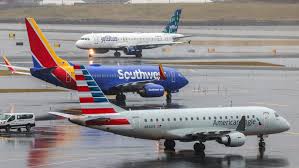American Airlines is taking steps to streamline the boarding process and ensure that passengers stick to their assigned boarding groups. The airline is currently testing new technology to enforce group boarding, aiming to curb the chaos that often occurs when eager travelers try to board earlier than their assigned slot.
The trial, which began in Albuquerque and Tucson, has already been well-received, with American Airlines planning to expand it to more locations, including Washington Reagan National Airport. The system, still in its early testing phase, issues an error beep if passengers attempt to board before their assigned group, prompting gate agents to redirect them.
A Reddit user who experienced the new process firsthand praised the system. “It was awesome to see this enforced. It seemed like it was system-driven, so gate agents didn’t have to make the call,” they wrote.
An American Airlines spokesperson confirmed the initiative, explaining that the new technology is designed to enhance the overall boarding experience. “We want to ensure customers receive the benefits of priority boarding with ease and to provide our team greater visibility into boarding progress,” the spokesperson said.
For airlines, efficient boarding is more than just a matter of convenience—it’s a way to maximize revenue. The longer a plane sits on the ground, the more money is lost. Yet, despite numerous attempts, airlines still struggle to find the perfect boarding method.
Astrophysicist Jason Steffen, who has extensively studied boarding techniques, developed what he considers the fastest method, aptly named the Steffen Method. This approach, which involves boarding six groups separated by seat location, may be efficient on paper, but implementing it in real life is another story.
“There are some challenges to implementing my method. It’s a solvable problem, but it has a cost,” Steffen told USA TODAY. He suggested that random boarding might be the next best option, though travelers likely wouldn’t favor that either.
American Airlines’ new system attempts to address the age-old issue of disorganized boarding by encouraging passengers to adhere to their group assignments. The move could lead to more orderly boarding, reduced stress, and a faster turnaround time for flights.
The airline has been pleased with the trial’s results so far. The technology also helps gate agents by giving them clearer oversight of the boarding process, reducing the need for staff intervention when passengers attempt to board out of turn.
America’s effort comes at a time when travelers’ preferences for overhead bin space continue to drive the need for earlier boarding. With many passengers hoping to secure space for their carry-ons, the company’s attempt to regulate the process may lead to a smoother, more efficient experience for all.
For now, American Airlines’ boarding tech is limited to just a few airports, but expansion plans are underway. The success of this initiative could inspire other airlines to adopt similar systems, potentially leading to a future where boarding a plane is less of a scramble and more of a seamless process.
While it remains to be seen whether American Airlines’ efforts will transform boarding on a larger scale, the initial feedback suggests that this new system may be a step in the right direction. For passengers, that could mean a less chaotic experience at the gate, and for airlines, a more efficient operation that keeps flights running on time.

